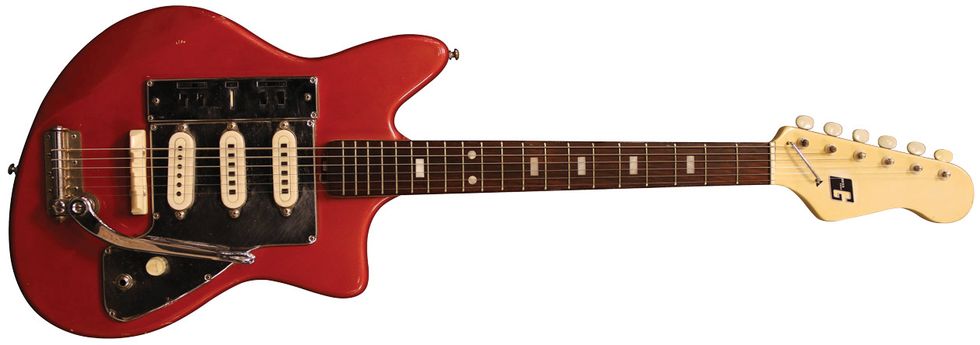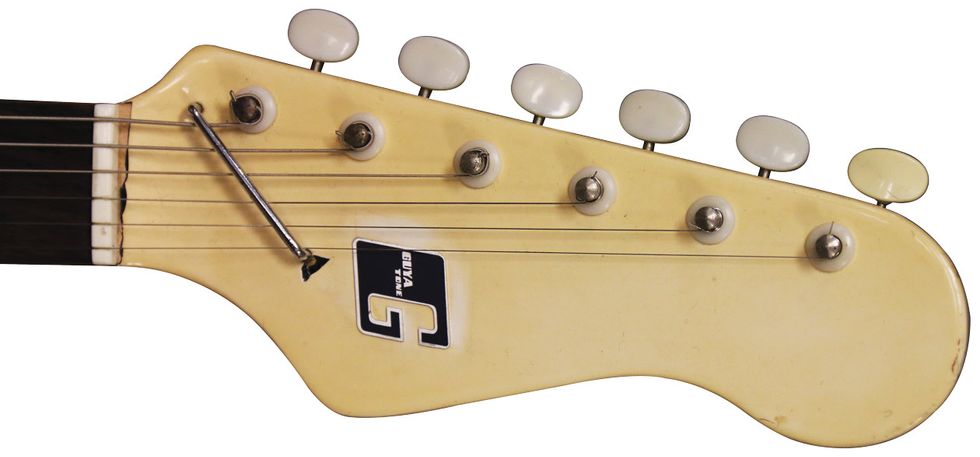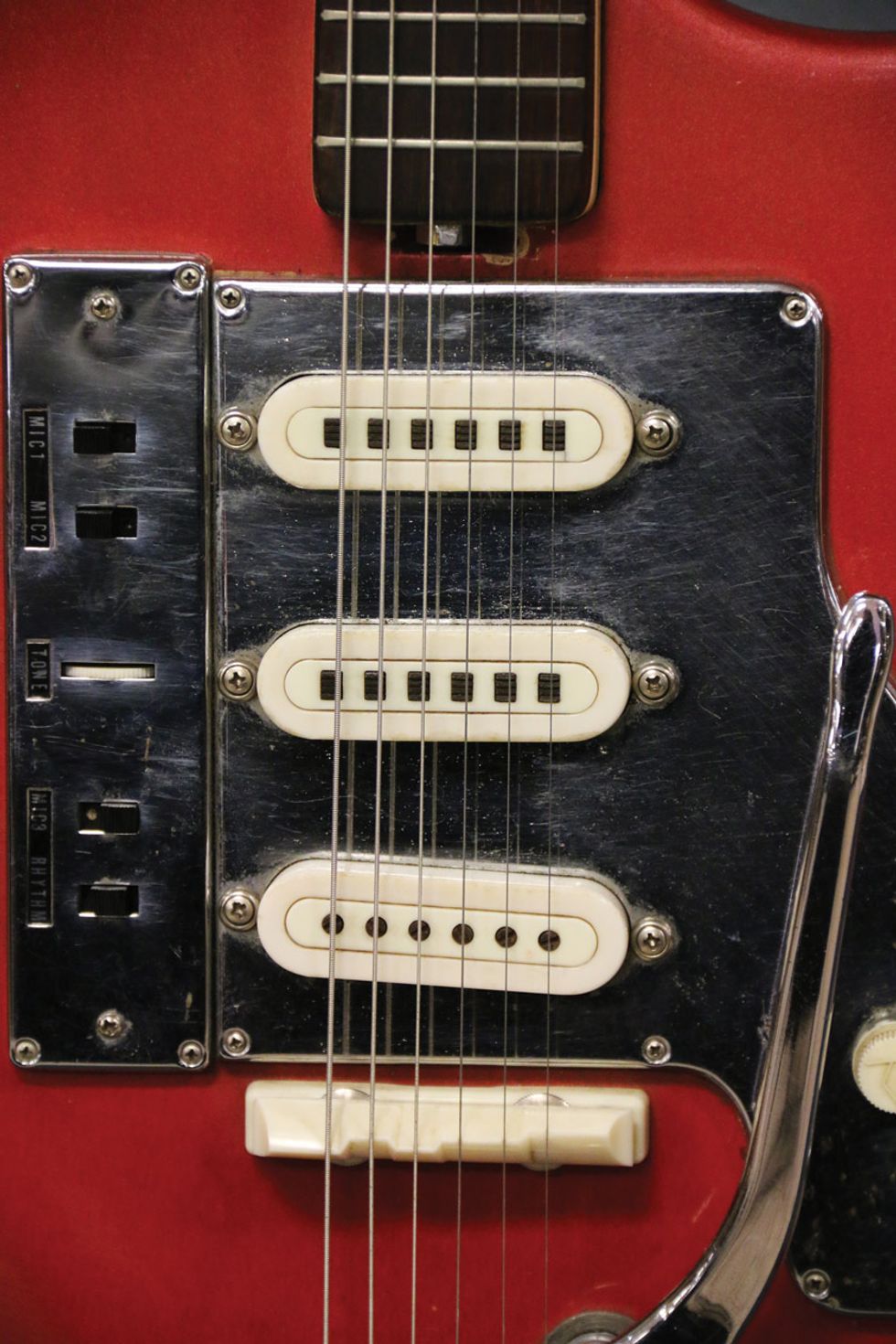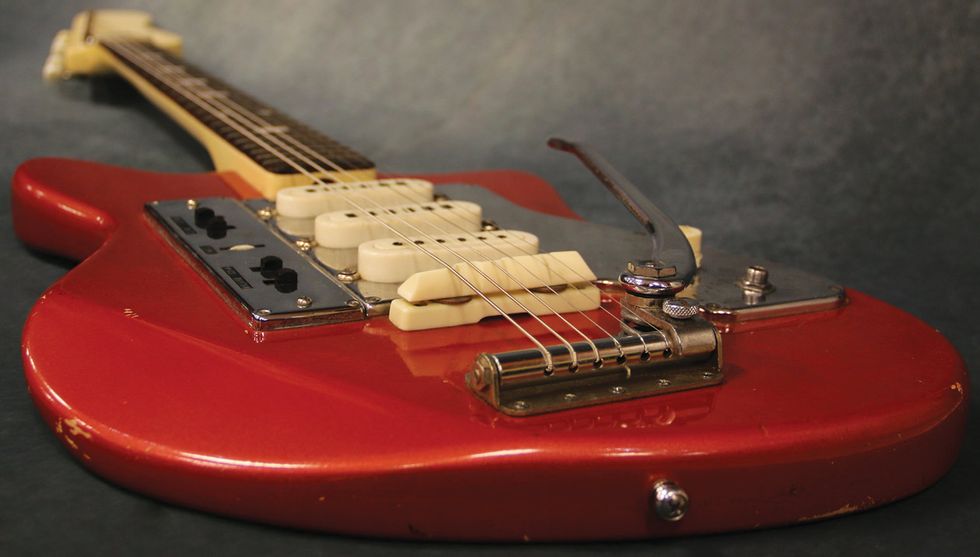While working in a music store in a guitar town like Nashville, I’ve seen interesting instruments that have been in the hands of journeymen players and their families for decades come through the doors regularly. A good example is this salmon-colored 1965 Guyatone model LG-130T—a recent arrival that has caught the eye of fans of the Guyatone/Kent/Teisco/Kawai style of Japan-made axes who come into the shop.
The Guyatone factory started building guitars way back in 1933 and was never too good about keeping records. By the mid-’50s, they had a factory in full production in Tokyo, and by late in the decade that plant was sometimes making 1,500 steel guitars, 1,600 electric guitars and basses, 2,000 amps, and 5,000 microphones a month, according to the company’s history at https://guyatoneus.com. Whew!
The headstock is yellowed with age and has some minimal chipping and flaking, but offsets the brand’s logo well. Note the simple string tree.
But back to our LG-130T. From the almost cream-colored wood on its neck to the fish-flavored finish (which Guyatone called cherry pink, and which helped date this instrument) to the three surprisingly crisp and present factory-made single-coil pickups, to its on/off switches for those pickups plus a tone wheel and a rhythm/lead switch, this guitar has lots of tonal variety and even more classic ’50s/’60s Japanese B-movie mojo. Guitarzilla, anyone? All of those things makes this a typical example of a mid-’60s LG-130, but this guitar has one thing that’s really unusual: a white baked-enamel headstock that looks really elegant atop its short-scale, 20-fret neck.
While the slide-button array recalls the Jazzmaster’s and Jaguar’s control sets, Guyatone’s pickups give these guitars a sound that’s perfect for gnarly blues, á la Hound Dog Taylor.
It’s easy for me to understand why so many artists who like to play on the fringes of blues eclecticism, including Ry Cooder and a young Jimi Hendrix, have enjoyed Guyatone guitars and their pickup tones. The neck is a flat-C profile that fits the hand comfortably. And the combination of on/off switches for the pickups allows a variety of sculpted sounds, while the rhythm/lead switch works similarly to that of a Jazzmaster. The 1-piece bridge is white plastic, but has two wheels to adjust its height. The vibrato arm feels and plays like a smaller version of a Bigsby, with a single spring and a screw for adjusting tension.
Like a Bigsby, this guitar’s whammy bar is a single-spring affair with a screw for adjusting tension. It does a decent job of staying in tune.
Without a doubt, there was a little idea thievery taking place when Guyatone’s designers were working up the LG-130T—especially from Fender’s Jaguars and Jazzmasters. Just check out the similar body shape and, at the top of the extended chrome pickguard, those pickup control switches. Plus, the neck joint. But those pickups, that pickguard, and the simple, distinctive whammy—which does a decent job of staying in tune—give the LG-130T its own identity. With its current value of just under $700 versus $4,000 to $5,000 for a mid-’60s Jazzmaster, it’s not the kind of guitar you’d mind making some modifications on unless you’re a hardcore collector of Japanese gems. This 6-string wouldn’t even be worth that much if not for its rare white Bakelite headstock.
One reason Guyatones are still pretty easy to find in the United States is that the company was the first Japanese guitar manufacturer to directly offer their product line to the American public. The first ads for Guyatone’s electrics appeared in the States in 1959. Guyatone also built guitars for other brands as the decades went on, and some of those guitars fell into the hands of influential players. Rory Gallagher and Hank Marvin played Guyatone-made guitars with Antoria, a brand name under which they were imported to the U.K., on their headstocks. And on the cover of his debut album, Hound Dog Taylor and the Houserockers, the rough and tumble bluesman Hound Dog Taylor is holding a Kawai S180, a four-pickup-equipped relative of our Guyatone LG-130T that was made in 1964 at the Guyatone plant.















![Rig Rundown: Russian Circles’ Mike Sullivan [2025]](https://www.premierguitar.com/media-library/youtube.jpg?id=62303631&width=1245&height=700&quality=70&coordinates=0%2C0%2C0%2C0)







